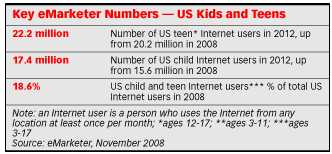
Yahoo's Widget Channel software for TVs shows a link to Yahoo's Flickr photo-sharing site, stock prices, and an advertisement. (Credit: Yahoo)
At CES 2009, Intel and Yahoo will reveal the latest in their Connected TV initiative, a program they hope will “mark the beginning of their Internet-fueled expansion to the world of TV.” According to CNET, the companies have different goals with the Connected TV initiative.
For Yahoo, it’s establishment of the Widget Channel, a software foundation that can house programs for browsing photos, using the Internet’s abundant socially connected services, watching YouTube videos, or digging deeper into TV shows–and through which Yahoo will be able to show advertisements. For Intel, it’s a foothold in an industry whose microprocessors have typically been cheaper, less powerful, and less power-hungry.
Internet-enabled TV (also called IPTV) has been a buzzword for years now, but it has also been filled with lots of empty promises for consumers. With that in mind, the Connected TV initiative has taken a consumer view, instead of a technology view, to figure out the future looks like. Thanks to the help of several of Intel-employed anthropologists, they concluded that:
Unlike the PC, TVs are social. People watch it together, and what they watch turns into what they talk about. Another difference from PCs: it must be simple and reliable. When bringing the Internet to the TV, You couldn’t just turn it into a PC.
Probing further, the anthropologists asked people what they thought the future of TV would look like. CNET reports that the answers fit into several key buckets:
- Something that would provide relevant information in real time, such as the weather right before heading to a sporting event.
- Something that would connect them to other people they care about, a variation of social networking.
- Something that would let them participate more with what they’re watching, for example by figuring out where a show’s cast members already had acted, or finding, rating, and sorting content.
- Not a full-on Web browser, nor a keyboard to clutter up the room.
Additionally,when Connected TV initiative showed consumers initial concepts, they learned that:
- People didn’t like the Widget Channel controls appearing on the left edge of the screen. Instead, people prefer the bottom, where they’re accustomed to seeing text already.
- People expressed a powerful desire for a big button to make the software go away in one fell swoop–no menus or arrow keys or complication–so they could get back to watching TV when they wanted. That big button is also used to activate the Widget Channel.
- Nobody wanted yet another remote control.
All of this research has led to the latest iteration of Internet-enabled TV that Yahoo and Intel will unveil at CES 2009. While I may be an optimist, I really think they have potential of pulling this off and bringing the promise of IPTV to life. Here’s why:
- An industry alliance can drive simplicity: The struggle for IPTV has always been the number of players involved. You need a solution that works for the TV manufacturers, cable companies, Internet media players, etc. The Connected TV initiative shows promise because it brings together Yahoo, Intel and multiple TV manufacturers. If IPTV is ever going to live up to the promise, it will take an alliance like this to pull off.
- Connected Consumers want information at their fingertips: When I mentioned this article on Twitter, Jon Burg asked if web-enabled TV is something consumers will care about in 2009. I think they will but only if it is information they care about and want in real-time. For instance, every Fall I sit with my laptop open on Sundays, tracking my Fantasy Football teams. I’d much rather have that info streaming through widgets on the TV while I watch the games. Same goes for customized CNN news feed or stock tracker running across the bottom of the screen.
- Advertisers want a replacement to interruption marketing: Lots of people have been forecasting the death of TV advertising. But let’s face it…that industry isn’t going away anytime soon as long as TV is central to people’s lives. However, marketers do want a replacement to the ever-increasingly DVR skipped :30 second TV ad. If marketers can join in the Connected TV initiative, they might just be able to help shape the future of TV advertising to one that is consumer-friendly…and dare I say, even beneficial to the consumer.
Whether or not the Connected TV initiative finally delivers on the high hopes of IPTV is anyone’s guess. But I’m hopeful they pull it off and equally intrigued by the opportunities it will open up for Brand Managers and marketers worldwide.
![Reblog this post [with Zemanta]](https://i0.wp.com/img.zemanta.com/reblog_e.png)



 Posted by Dave Knox
Posted by Dave Knox 











 Hard Knox Life is the blog of Dave Knox, a classic CPG Brand Manager. It is about marketing, media & technology and how those forces are changing the job of a Brand Manager.
Hard Knox Life is the blog of Dave Knox, a classic CPG Brand Manager. It is about marketing, media & technology and how those forces are changing the job of a Brand Manager.







